The Only Guide to Dental Sense
The Only Guide to Dental Sense
Blog Article
Getting My Dental Sense To Work
Table of ContentsSome Known Incorrect Statements About Dental Sense Some Known Facts About Dental Sense.Facts About Dental Sense UncoveredThe Facts About Dental Sense Uncovered
are medical devices surgically implanted right into the jaw to recover an individual's ability to eat or their appearance. They offer support for artificial (phony) teeth, such as crowns, bridges, or dentures. When a tooth is shed because of injury or illness, an individual can experience problems such as rapid bone loss, defective speech, or changes to eating patterns that result in pain.Dental dental implant systems include a dental implant body and oral implant abutment and might also consist of an abutment fixation screw. Kids dental. The dental implant body is operatively placed in the jawbone in area of the tooth's origin. The dental implant joint is normally connected to the dental implant body by the abutment addiction screw and expands via gums right into the mouth to sustain the attached synthetic teeth
(https://businesslistingplus.com/profile/dentalsense1/)Structure of The Oral Implant System picking oral implants, talk with your oral service provider concerning the possible advantages and dangers, and whether you are a prospect for the treatment. Points to consider: Your overall health is an essential consider figuring out whether you are a good candidate for oral implants, the length of time it will take to heal, and how long the implant may stay in place.
Smoking might influence the healing process and lower the long-lasting success of the dental implant. The healing process for the dental implant body might take a number of months or longer, during which time you normally have a short-term abutment instead of the tooth. the oral implant procedure: Meticulously adhere to the dental hygiene directions given to you by your dental company.
More About Dental Sense
Implant failure can cause the demand for an additional operation to repair or change the dental implant system. Brings back the capacity to chew Brings back aesthetic appearance Aids keep the jawbone from diminishing due to bone loss Protects the wellness of the surrounding bone and gum tissues Helps maintain surrounding (nearby) teeth steady Boosts high quality of life Damage to bordering all-natural teeth throughout implant placement Injury to the surrounding cells during surgical treatment, such as sinus opening Injury during surgery (as an example, fracture of bordering jawbone) Inadequate function, such as really feeling like the teeth do not attack together generally An experience that the tooth is loose or twisting in place arising from an abutment screw loosening Implant body failing (looseness of the implant body) due to systemic infection, which may be more probable in clients with unchecked diabetes due to neighborhood infection in bone and periodontals supporting the dental implant body due to postponed healing, which may be more probable in people that smoke Difficulty cleaning the gum tissues around the implant, leading to poor dental health Untreated gum condition Post-surgical numbness because of nerve impingement or damages Always inform health treatment suppliers and imaging technicians that you have dental implants prior to any magnetic vibration imaging (MRI) or x-ray procedures.
FDA is not familiar with any type of damaging events reported for MRI or x-ray procedures with dental implants. Oral implants systems are generally made from products that adhere to global agreement requirements of the International Organization for Standardization (ISO) or ASTM International. These requirements have details of what makes a safe product.

A dental implant is a structure that changes a missing out on tooth. With screw-like tools, the cosmetic surgeon inserts a dental implant into the jawbone, and it acts as a support for a synthetic tooth, called a crown.
Not known Factual Statements About Dental Sense
Some individuals are not qualified for dental implant surgical treatment. It is for dental specialists to operate people with: severe illnessuncontrollable metabolic diseasebone or soft tissue condition or infectionIf these issues are settled, a person can have the surgery. In, dental cosmetic surgeons refrain from operating individuals with: If individuals with any one of the above go through dental implant surgery, there is a greater danger of the implant failing.

Oral dental implant surgical procedure is a tailored process. Offer you time to heal. Attach the post and final crown, bridge or denture.
Next, your surgeon will very carefully position the oral implant right into your jaw. Your doctor will certainly rearrange your gum tissues and shut the laceration with stitches. If your dental implant is near the front of your mouth, your dentist will make a short-term tooth for you to wear until you heal. This way, you will not have a void in your smile while you recoup.
Not known Details About Dental Sense
During the recovery phase, your jawbone must fuse to the dental implant. This process can take anywhere from 3 to nine months.
When your implant heals, your dental practitioner can connect the joint (small connector article) and your last remediation (crown, bridge or denture). This generally takes about one hour to finish and might need a 2nd small surgery. You should not feel any type of pain during your dental implant treatment due to the fact that your supplier will certainly utilize medication to numb your gum tissues.
Report this page